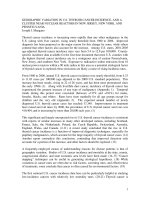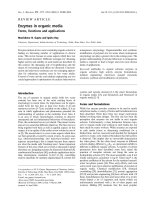Molecular Imaging: An Essential Tool in Preclinical Research, Diagnostic Imaging, and Therapy potx
Bạn đang xem bản rút gọn của tài liệu. Xem và tải ngay bản đầy đủ của tài liệu tại đây (4.56 MB, 269 trang )
Ernst Schering Research Foundation Workshop 49
Molecular Imaging
Ernst Schering Research Foundation
Workshop 49
Molecular Imaging
An Essential Tool in Preclinical Research,
Diagnostic Imaging, and Therapy
A. A. Bogdanov Jr., K. Licha
Editors
With 79 Figures
12
Series Editors: G. Stock and M. Lessl
Library of Congress Control Number: 2004103454
ISSN 0947-6075
ISBN 3-540-21021-0 Springer Berlin Heidelberg New York
This work is subject to copyright. All rights are reserved, whether the whole or part of the
material is concerned, specifically the rights of translation, reprinting, reuse of illustrations,
recitation, broadcasting, reproduction on microfilm or in any other way, and storage in data
banks. Duplication of this publication or parts thereof is permitted only under the provisions
of the German Copyright Law of September 9, 1965, in its current version, and permission
for use must always be obtained from Springer-Verlag. Violations are liable for prosecution
under the German Copyright Law.
Springer is a part of Springer Science+Business Media
springeronline.com
° Springer-Verlag Berlin Heidelberg 2005
Printed in Germany
The use of general descriptive names, registered names, trademarks, etc. in this publication
does not imply, even in the absence of a specific statement, that such names are exempt
from the relevant protective laws and regulations and therefore free for general use. Product
liability: The publishers cannot guarantee the accuracy of any information about dosage and
application contained in this book. In every individual case the user must check such infor-
mation by consulting the relevant literature.
Editor: Dr. Ute Heilmann, Heidelberg
Desk editor: Wilma McHugh, Heidelberg
Production editor: Andreas Gæsling, Heidelberg
Cover design: design & production GmbH, Heidelberg
Typesetting: K+V Fotosatz GmbH, Beerfelden
Printed on acid-free paper ± 21/3150/AG-5 4 3 2 1 0
Preface
ªMolecular imagingº has been previously defined as ªthe in vivo
characterization and measurement of biologic processes at the cellu-
lar and molecular level.º This broad definition emerged during the
last few years as a consequence of the convergence of molecular and
cell biology with imaging science, including medical physics and
technology. One of the major goals of molecular imaging has be-
come the development of noninvasive strategies of ªmolecular profil-
ingº in living subjects, i.e., the acquisition and analysis of maps re-
flecting the spatial and temporal distribution of a given molecular
target at a precise anatomical location without biopsies. The map-
ping of disease-relevant gene expression profiles in vivo would be
especially important for individualizing established therapy regimens
in clinical practice and selecting patients for novel experimental
therapies.
The 49th Ernst Schering Foundation Workshop, ªMolecular Imag-
ing; An Essential Tool in Preclinical Research, Diagnostic Imaging,
and Therapy,º is the second in the history of the foundation devoted
to this topic. The purpose of the workshop was to discuss and over-
view multiple applications and emerging technologies in the area of
diagnostic imaging including its fundamental capabilities in preclini-
cal research, the opportunities for medical care, and the options in-
volving therapeutic concepts. The contributions from leading clinical
and basic researchers included in this book clearly demonstrate the
large strides that are being taken in recent years toward attaining the
scientific goals of molecular imaging, and toward translating new
ideas in this exciting and rapidly evolving field into practical bene-
fit. Scientific disciplines covered in the workshop were molecular
and cell biology, synthetic chemistry and radiochemistry, spectro-
scopic and magnetic analytics, and imaging techniques. From the
perspective of application, the workshop included topics in the area
of magnetic resonance imaging, radiodiagnostics (PET and SPECT),
radiotherapy, ultrasound imaging, optical imaging, and photodynam-
ic therapy.
Feedback from the participants led to the conclusion that the in-
terdisciplinary nature and scientific diversity of this area of science
was well reflected during the workshop, attracted great interest, and
led to a better understanding of each other's expertise and knowledge.
We wish to express our sincere gratitude to all participants for
their contributions to the workshop and to this book. We also thank
the Ernst Schering Research Foundation for the generous support in
making the workshop a great success.
VI Preface
Contents
1 Oligonucleotides as Radiopharmaceuticals
B. Tavitian
1
2 Imaging Protein-Protein Interactions in Whole Cells
and Living Animals
D. Piwnica-Worms, K.E. Luker
35
3 Radiolabeled Peptides in Nuclear Oncology:
Influence of Peptide Structure and Labeling Strategy
on Pharmacology
H. R. Maecke
43
4 Pretargeted Radioimmunotherapy
G. Paganelli 73
5 PET/CT: Combining Function and Morphology
T.F. Hany, G. K. von Schulthess 85
6 High Relaxivity Contrast Agents for MRI
and Molecular Imaging
S. Aime, A. Barge, E. Gianolio, R. Pagliarin, L. Silengo,
L. Tei
99
7 Luminescent Lanthanide Complexes as Sensors
and Imaging Probes
D. Parker, Y. Bretonnire
123
8 Magnetic Resonance Signal Amplification Probes
A. A. Bogdanov Jr., J.W. Chen, H. W. Kang,
R. Weissleder
147
9 Imaging of Proteases for Tumor Detection
and Differentiation
C. Bremer
153
10 Molecular Imaging with Targeted Ultrasound Contrast
Microbubbles
A. L. Klibanov
171
11 Noninvasive Real-Time In Vivo Bioluminescent Imaging
of Gene Expression and of Tumor Progression
and Metastasis
C. W. G. M. Lowik, M. G. Cecchini, A. Maggi,
G. van der Pluijm
193
12 Targeted Optical Imaging and Photodynamic Therapy
N. Solban, B. Ortel, B. Pogue, T. Hasan
229
Previous Volumes Published in This Series 259
VIII Contents
List of Editors and Contributors
Editors
Bogdanov, A.A. Jr.
Center for Molecular Imaging Research, Building 149,
Massachusetts General Hospital, 13th Street, Charleston,
MA 02129, USA
e-mail:
Licha, K.
Medicinal Chemistry 6, Schering AG, Mçllerstr. 170±178,
13342 Berlin, Germany
e-mail:
Contributors
Aime, S.
Dipartimento di Chimica I.F.M. e Centro per il Molecular Imaging,
Universit di Torino, Via P. Giuria 7, 10125 Turin, Italy
e-mail:
Barge, A.
Dipartimento di Chimica I.F.M. e Centro per il Molecular Imaging,
Universit di Torino, Via P. Giuria 7, 10125 Turin, Italy
e-mail:
Bremer, C.
Westfålische Wilhelms-Universitåt, Mçnster Institut fçr Klinische
Radiologie, Albert-Schweitzer-Straûe 33, 48129 Mçnster, Germany
e-mail:
Bretonnire, Y.
University of Durham Department of Chemistry, South Road,
Durham DH1 3LE, UK
e-mail:
Cecchini, M. G.
Urology Research Laboratory, Department of Urology and Department
of Clinical Research, University of Bern, MEM C813, Murtenstr. 35,
3010 Bern, Switzerland
e-mail:
Chen, J. W.
Massachusetts General Hospital, Center for Molecular Imaging
Research, Building 149, 13th Street, Charleston, MA 02129, USA
Gianolio, E.
Dipartimento di Chimica I.F.M. e Centro per il Molecular Imaging,
Universit di Torino, Via P. Giuria 7, 10125 Turin, Italy
e-mail:
Hany, T.F.
University Hospital Zurich Dept. of Medical Radiology/Division
of Nuclear Medicine, Råmistraûe 100, 8091 Zurich, Switzerland
e-mail:
Hasan, T.
Wellmann Laboratories of Photomedicine, Harvard Medical School
Massachusetts General Hospital, 540 Blossom Street, Bartlett 314,
Boston, MA 02114, USA
e-mail:
Kang, H. W.
Massachusetts General Hospital, Center for Molecular Imaging
Research, Building 149, 13th Street, Charleston, MA 02129, USA
Klibanov, A. L.
University of Virginia Medical Center, Cardiovascular Division,
Box 100158, Charlottesville, VA 22908, USA
e-mail:
X List of Editors and Contributors
Lowik, C.
Department of Endocrinology, Building 1, C4-R86 Leiden University
Medical Center, Albinusdreet 2, 2333 ZA Leiden, The Netherlands
e-mail:
Luker, K. E.
Molecular Imaging Center, Mallinckrodt Institute of Radiology, and
Department of Molecular Biology and Pharmacology, Washington
University Medical School, Box 8225, 510 S. Kingshighway Blvd,
St. Louis, MO 63110, USA
Maecke, H. R.
Institute of Nuclear Medicine, Division of Radiological Chemistry,
University Hospital Basel, 4031 Basel, Switzerland
e-mail:
Maggi, A.
Department of Pharmacological Sciences and Center of Excellence
on Neurogenerative Disease, University of Milan, Italy
Ortel, B.
Wellman Laboratories of Photomedicine, Department of Dermatology,
Massachusetts General Hospital, Harvard Medical School, Boston,
MA 02114, USA
e-mail:
Paganelli, G.
European Institute of Oncology, Division of Nuclear Medicine,
20141 Milan, Italy
e-mail:
Pagliarin, R.
Dipartimento di Chimica Organica e Industriale,
Universit di Milano, Viale Venezian 21, 20133 Milan, Italy
Parker, D.
University of Durham Department of Chemistry, South Road,
Durham DH1 3LE, UK
e-mail:
List of Editors and Contributors XI
Piwnica-Worms, D.
Washington University School of Medicine Molecular Imaging Center,
510 S. Kingshighway Blvd, Box 8225 St. Louis, MO 63110, USA
e-mail:
van der Pluijm, G.
Department of Endocrinology, Building 1, C4-R86 Leiden University
Medical Center, Albinusdreet 2, 2333 ZA Leiden, The Netherlands
Pogue, B.
Wellman Laboratories of Photomedicine, Department of Dermatology,
Massachusetts General Hospital, Harvard Medical School, Boston,
MA, 02114, USA
Thayer School of Engineering, Dartmouth College, Hanover,
NH 03755, USA
von Schulthess, G. K.
Clinic and Policlinic of Nuclear Medicine, University Hospital Zçrich,
Råmistrasse 100, 8091 Zurich, Switzerland
Silengo, L.
Dipartimento di Genetica, Biologia e Biochimica, Universit di Torino,
Via Santona 5-bis, 10126 Turin, Italy
Solban, N.
Wellman Laboratories of Photomedicine, Department of Dermatology,
Massachusetts General Hospital, Harvard Medical School, Boston,
MA 02114, USA
Tavitian, B.
INSERM ERM 103 Service Hospitalier, Frdric Joliot CEA Direction
des Sciences du Vivant Direction de la Recherche Medicale, 4 place du
General Leclerc, 91401 Orsay Cedex, France
e-mail:
Tei, L.
Dipartimento di Medicina Interna, Universit di Torino, C. so Dogliotti
14, 10125 Turin, Italy
Weissleder, R.
Massachusetts General Hospital, Center for Molecular Imaging
Research, Building 149, 13th Street, Charleston, MA 02129, USA
e-mail:
XII List of Editors and Contributors
1 Oligonucleotides
as Radiopharmaceuticals
B. Tavitian
If medicine is molecular, then imaging should become molecular.
Henry Wagner Jr.
1.1 Imaging of Oligonucleotides 5
1.1.1 Radiolabeling of Oligonucleotides 5
1.2 Imaging In Vivo Pharmacokinetics and Biodistribution
of Oligonucleotides 8
1.3 Comparative Pharmaco-Imaging of Oligonucleotides 9
1.3.1 Effect of Length 9
1.3.2 Influence of Chemistry 9
1.4 Evaluation of Delivery Vectors for Oligonucleotides 11
1.5 Imaging with Oligonucleotides 13
1.5.1 Antisense Oligonucleotides 13
1.6 Antisense Oligonucleotides
for Gene-Related Disease Therapy 14
1.7 Improving Antisense for In Vivo Applications 15
1.8 In Vivo Imaging Studies with Antisense Oligonucleotides . . . 16
1.9 Aptamer Oligonucleotides 18
1.10 Applications and Therapeutic Aptamers 21
1.11 Aptamers as Contrast Agents for Diagnosis 22
1.12 Future Developments Needed for In Vivo Imaging
with Oligonucleotides: Mastering the Nonspecific Interactions
and Signal-to-Noise Ratio 23
1.12.1 Sensitivity 24
1.12.2 Affinity 24
1.12.3 ªNonspecificº Binding 25
1.13 Conclusion 26
References 26
In a general sense, molecular imaging is a term used to define in
vivo imaging of molecules and stands in contrast to anatomical or
physiological imaging. In that sense, any type of imaging that uses
molecules as indicators or addresses molecules as targets is molecu-
lar, e.g., fluorodeoxyglucose (FDG), positron emission tomography
(PET) scanning or octreotide single photon emission computed
tomography (SPECT) are molecular imaging techniques. In a more
restrictive sense however, the field of molecular imaging stands in
respect to imaging just as molecular biology stands in respect to bio-
logical chemistry, i.e., it deals with nucleic acids and genetics. This
part of molecular imaging, also referred to as genetic molecular
imaging (Blasberg 2002) is booming thanks to the reporter gene
imaging technologies developed in the 1990s in the United States,
which have progressed to the point that they can be applied in hu-
mans (Jacobs et al. 2001).
The parallel between molecular biology and molecular imaging is
representative of where the imaging science stands today, that is, at
the point where molecular biology was twenty years ago. Both fields
of research have the capacity to introduce and detect reporter genes
in biological tissues, e.g., b-galactosidase for molecular biology and
thymidine kinase for molecular imaging. However, molecular imag-
ing is still far from the achievements of molecular biology that
started it as an ªindustryº working at a very large scale: the ability
to analyze specifically any given gene. This was made possible by
two inventions: the detection of specific sequences among DNA
fragments separated by gel electrophoresis (Southern 1975) and the
phosphoramidite chemistry allowing to synthesize ad libitum small
pieces of nucleic acids (Caruthers and Beaucage 1980).
Oligonucleotides were the key molecular tools for both inven-
tions. Oligo (Greek for ªfewº) nucleotides are short polymers of nu-
cleotides, the building blocks of nucleic acids consisting in a 5-car-
bon sugar, a phosphate group, and any one of four different nucleo-
bases (Fig. 1). Being small pieces of nucleic acids endows oligonu-
2 B. Tavitian
cleotides with the biological properties of these nucleic acids, i.e.,
the capacity to stock and transmit genetic information (Fig. 2). Oli-
gonucleotides are exquisitely precise molecular gene tools with in
vitro usages that are growing exponentially, notably the major mo-
lecular biology methods of detecting specific gene expressions such
as PCR, biochip arrays, in situ hybridization, etc. In addition, oligo-
nucleotides have demonstrated the capacity to control gene expres-
sion in many different ways, some of which, such as siRNA (small
interfering double-stranded RNA), have been unveiled only recently
(Table 1). Interestingly, many mechanisms by which oligonucleotides
control gene expression have been the subject of intense, sometimes
excessive speculations for biomedical applications, often before
Oligonucleotides as Radiopharmaceuticals 3
Fig. 1. Structure of oligonucleotides. T, thymine; A, adenine; C, cytosine;
G, guanine. X is O in phosphodiester, S in phosphorothioate, and CH
3
in
methylphosphonate. Y is H in deoxyribonucleotides, OH in ribonucleotides,
and O-CH
3
in 2'-O-methyl ribonucleotides
4 B. Tavitian
Fig. 2. Oligonucleotides and biological information
Table 1. Oligonucleotides are modulators of gene expression
Oligo- Target Mechanism of activity
nucleotide
Base pairing Molecular
recognition
Antisense RNA + ± Double helix
Ô enzymatic
Ribozyme RNA Ô ± Enzymatic
Antigene DNA + ± Triple helix
Tweezer RNA + ± Triple helix
Sense DNA/RNA ± + Binding
Binding
Protein
Aptamer Any ± + Binding
SiRNA,
lRNA
RNA + ± Recognition
+ enzymatic
these mechanisms were demonstrated to exist in living organisms
(Lavorgna et al. 2003).
Molecular imaging lags behind molecular biology, and the meth-
ods that would allow the specific detection of any given gene by
noninvasive imaging techniques are still sky-high. A major challenge
of molecular imaging is to turn molecular biology tools such as oli-
gonucleotides into in vivo imaging agents, just as reporter genes and
probes have been recently. Naturally, the difficulties of the task
should not be underestimated including, among those apparent at
first sight, the fact that all organisms have developed efficient strate-
gies to avoid invasion by foreign nucleic acids. Efficient delivery is
the key to oligonucleotide imaging, as it is to molecular medicine in
general (Jain 1998).
This chapter inventories the present use of oligonucleotides as
radiopharmaceuticals. It exposes first the applications of imaging to
oligonucleotides, viz. imaging of oligonucleotides, and then the ap-
plications of oligonucleotides to imaging, viz. imaging with oligonu-
cleotides. Based on the present state-of-the-art conditions, I hope to
convince the reader that imaging of oligonucleotides is a reality with
numerous applications, while imaging with oligonucleotides, still in
its infancy, is a major avenue for the exploration of gene expression.
1.1 Imaging of Oligonucleotides
1.1.1 Radiolabeling of Oligonucleotides
Methods to radiolabel oligonucleotides with iodine-125, iodine-123,
indium-111, technetium-99m, carbon-11, fluorine-18, bromine-76,
and gallium-68 for imaging studies have been described (Table 2; re-
viewed in Younes et al. 2002). All these methods modify the oligo-
nucleotide, either by covalent attachment of labeled groups or by ad-
dition of isotope chelating groups. Several studies have reported that
the hybridization capacity of the oligonucleotide is maintained un-
changed after labeling (Hnatowich et al. 1995; Tavitian et al. 1998;
Roivanen et al. 2004). In contrast, the labeling is not without conse-
quences on the pharmacokinetics. For instance, technetium-99m che-
lating groups modify the accumulation and efflux of octodecanucleo-
Oligonucleotides as Radiopharmaceuticals 5
6 B. Tavitian
Table 2. Oligonucleotide radiolabeling methods for imaging
Isotope Labeling group Labeling method
Iodine-125 p-Methoxyphenyl isothio-
cyanate (PMPITC)
5' Aminohexyl group
Iodine-125 Iodo-tyramine 5' Amido
Iodine-125 4-Iodobenzamide 5' Tributylstannylbenz-
amide
Iodine-125 Iodobenzoacetamide 5' Thiophosphate
Iodine-125 Iodo dCTP Primer extension with
DNA pol I
Iodine-123 Iodovinyl analog of 2'-
deoxy-U
5' End incorporation of
stannyl U derivative
Indium-111 Diethylenetriaminepenta-
acetate (DTPA)
Isothiocyanate
Indium-111 Isothiocyanobenzyl-EDTA Amino-dU
Technetium-99m Hydrazino nicotinamide N-hydroxysuccinimide
derivative
Technetium-99m MAG3 (benzoylmercapto-
glycylglycylglycine)
Amine derivative
Technetium-99m MAG3 (benzoylmercapto-
glycylglycylglycine)
3' Hexylamine
Technetium-99m MAG2 Amino
Carbon-11 Butyrate from ethylketene Hexylamine
Fluorine-18 4-([
18
F]Fluoromethyl)phenyl
isothiocyanate
5'-Hexylamine derivative
Fluorine-18 N-succimidyl
4-[
18
F]fluorobenzoate
5'-Hexylamine derivative
Fluorine-18 [
18
F]fluorobenzylbromoacet-
amide
3'-Thiophosphate
Fluorine-18 5'-Deoxy-5'-fluoro-O
4
-
methylthymidine
5'-Phosphoramidite
Fluorine-18 [
18
F]fluorobenzylbromo-
acetamide
Cysteine (PNA)
Bromine-76 N-Succinimidyl
4-[
76
Br]Bromobenzoate
5'-Hexylamine derivative
Gallium-68 DOTA (1,4,7,10-tetraaza-
cyclododecane-N,N',N'',N'''-
tetraacetic acid)
5'-Aminohexyl
tide antisense DNA against the Ria subunit of PKA in the kidney
cancer cell line ACHN (Zhang et al. 2001). The biodistribution in
normal mice is also heavily influenced by the labeling method: 4 h
following the injection of
99m
Tc-labeled DNA, the percentage of in-
jected dose per gram (ID/g) varied from 2.5 to 30.1 in kidney and
3.3 to 24 in liver for MAG3 and HYNIC chelators, respectively.
From these studies, Hnatowich and his group concluded that biodis-
tribution of intravenously administered oligonucleotides depends on
the method for radiolabeling the antisense oligonucleotide, and that
this method should be adapted to the organ localization of the target
gene (Zhang et al. 2001).
In this respect, positron emitters such as carbon-11 and fluorine-
18 have the advantage over metal c-emitters that they can be incor-
porated into small molecular structures leading to limited chemical
modification of the oligonucleotide. Our laboratory has developed
generic methods to label oligonucleotides with fluorine-18 (Fig. 3).
Radiolabeling is performed in two steps, (a) radiolabeling of a syn-
thon designed for high reactivity and stable incorporation of halo-
gens, and (b) regioselective conjugation of the synthon to the oligo-
nucleotide. Performing the radiosynthesis of the synthon separately
from the synthesis of the oligonucleotide allows (a) high yield incor-
Oligonucleotides as Radiopharmaceuticals 7
Fig. 3. Fluorine-18 labeling of oligonucleotides as described in Doll et al.
1997; Kçhnast et al. 2000a, b, 2002, 2003a,b
poration in an activated C6 aromatic ring of the halogen through the
use of harsh conditions that would not be compatible with the stabil-
ity of the oligonucleotides, (b) HPLC purification of the synthon
from other radioactive by-products, and (c) its coupling to any oligo-
nucleotide obtained in-house or commercially, without tedious un-
blocking steps to protect the oligonucleotides from unwanted reac-
tions. The coupling reaction itself is designed to be rapid and effi-
cient in conditions compatible with the chemical stability of the oli-
gonucleotides and the half-life of isotopes.
The method is workable with short and long oligonucleotides and
is independent of both the base sequence and the chemistry of the
backbone. It has been applied to phosphodiester (Doll et al. 1997),
phosphorothioate, methylphosphonate, carbon 2'-modified ribose
ribonucleotides (Kçhnast et al. 2000a,b), peptide nucleic acids
(Kçhnast et al. 2002; Hamzavi et al. 2003), and enantiomeric ribo-
and deoxyribo-nucleotides (Kçhnast et al 2003a). The label can be
conjugated either at the 3' end or at the 5' end of the oligonucleotide
(Kçhnast et al 2003b). The same procedure can be used to label oli-
gonucleotides with iodine-125 (Kçhnast et al. 2000b).
1.2 Imaging In Vivo Pharmacokinetics and Biodistribution
of Oligonucleotides
A generic labeling method for oligonucleotides opens the possibility
of imaging the pharmacodistribution of virtually any present or fu-
ture modification aimed at improving the bioavailability of oligonu-
cleotides. Together with metabolic analysis, it allows direct evalua-
tion of the characteristics of labeled oligonucleotides as in vivo trac-
ers and is most useful for drug and radiotracer design and develop-
ment of oligonucleotides.
Systematically administered oligonucleotides must escape plas-
matic and tissular nucleases and cross various biological membranes
in order to reach their cellular target. Many technological tricks have
been explored in order to circumvent the efficient mechanisms by
which living organisms protect themselves from an invasion by exo-
genously administered nucleic acids, such as modifications of the
natural oligonucleotides' backbones that enhance their stability with-
8 B. Tavitian
out being deleterious to their activity. Another line of research is to
incorporate oligonucleotides into synthetic vectors acting as Trojan
horses (Prochiantz 1998) able to simultaneously protect them against
nucleic attack and direct them inside cells. In vivo imaging of oligo-
nucleotides is a powerful technique to evaluate the outcome of both
these strategies.
1.3 Comparative Pharmaco-Imaging of Oligonucleotides
1.3.1 Effect of Length
Most oligonucleotides tested for in vivo applications range between
8 and 25 nucleotides, a compromise between specificity which in-
creases with length, and bioavailability which decreases with size.
Langstræm et al. reported the pharmacodistribution of [
76
Br]-labeled
oligonucleotides of different lengths (6, 12, 20, and 30 bases) target-
ing the rat Chromogranin A mRNA (Wu et al. 2000). Distribution
was clearly dependent on length, with the highest uptake in the kid-
ney cortex for the shortest, and in the liver and spleen for the long-
est oligonucleotides. Significant uptake in the adrenals remained at
modest values and was observed only with the 20- and 30-mer
oligonucleotides.
1.3.2 Influence of Chemistry
Few studies have explored the general pharmacological profile of
oligonucleotides in the absence of a defined target. Hnatowich et al.
imaged (
99m
Tc)-labeled phosphodiester and phosphorothioate 22-mer
oligonucleotides in normal mice (Hnatowich et al. 1996). Both com-
pounds showed low molecular weight metabolites, demonstrating
that phosphorothioate is not totally stable in vivo and shows high
levels of protein binding. Whole body clearance was much slower
for the phosphorothioate than for the phosphodiester (PO) due to a
high hepatic uptake of the phosphorothioate (PS). The authors con-
cluded the phosphodiester DNA may be the preferred
99m
Tc-labeled
Oligonucleotides as Radiopharmaceuticals 9
oligonucleotide to avoid the high and persistent liver uptake ob-
served with the phosphorothioate DNA.
Our laboratory performed imaging studies with 3'-end [
18
F])-la-
beled oligonucleotides, concentrating on the pharmacodistribution
differences between phosphodiester, phosphorothioate, and 2'-O-
methyl RNA (34). The same sequence, negative for any endogenous
complementary sequence match, was constructed with these 3 che-
mistries, [
18
F]-labeled at its 3' end, and imaged in nonhuman pri-
mates (Tavitian et al. 1998). Metabolic analysis in plasma sampled
at regular time intervals after injection showed a rapid degradation
of the phosphodiester (half-life in the plasma 3±5 min) and compari-
son with the unlabeled ODN indicated that metabolism was not sig-
nificantly modified by labeling. In contrast, labeled phosphorothioate
and 2'-O-methyl RNA remained intact in plasma during the 2 h fol-
lowing injection. Pharmacodistribution of the radioactivity showed
that the phosphodiester was eliminated both through the renal and
the digestive system, while the phosphorothioate and 2'-O-methyl
RNA showed only renal excretion. The phosphorothioate showed
persistent accumulation in the liver (0.1% of injected dose per ml of
tissue between 20 and 80 min after injection) while the 2'-O-methyl
RNA accumulated in the kidney (0.03% at 80 min after injection).
The data reported in this study showed (a) that the radiolabeling
method has no detrimental effect on the capacity of the antisense
oligonucleotide to hybridize to its target complementary sequence;
(b) that after i.v. injection of the [
18
F]oligonucleotide it is possible
to quantitatively evaluate by PET the kinetics of [
18
F] radioactivity
in any selected tissue or organ; (c) that these kinetics are highly
variable with the nature of the oligonucleotide backbone; and (d)
that it is possible to measure the concentration of
18
F-labeled meta-
bolites in the plasma during the PET measurements, opening the
way to the quantitative evaluation of the tissular concentrations of
[
18
F]oligonucleotide. Overall it demonstrated that this approach was
relevant for the comparative evaluation of oligonucleotides in vivo
(Tavitian et al. 1998).
In a study published just recently, Roivanen and coworkers re-
peated the comparison of phosphodiester, phosphorothioate and 2'-
O-methyl RNA labeled with the positron emitter gallium-68, in rats.
Surprisingly, they found high uptake of the phosphorothioate in kid-
10 B. Tavitian
neys, and low plasmatic stability of the 2'-O-methyl RNA (Roivanen
et al. 2004). The difference between these results and those obtained
in our laboratory may be explained by the different species and/or
labeling methods used in the two studies and call for further phar-
macokinetics studies of oligonucleotides.
1.4 Evaluation of Delivery Vectors for Oligonucleotides
Chemical modifications may decrease sequence specificity and/or
activity of oligonucleotides, and have little or no effect or may even
be deleterious for membrane passage. In contrast, even nuclease-sen-
sitive oligonucleotides can be protected by synthetic vectors man-
made on the basis of their known physico-chemical properties.
Many attempts have been made to include oligonucleotides into vec-
tors such as cationic lipids or polyamines in order to improve cellu-
lar uptake and internalization, and also to ensure protection against
nucleases. Among the difficulties most commonly encountered with
synthetic vectors are the capture of particulate material by cells of
the reticulo-endothelial system, immunogenicity or toxicity of the
delivery vehicle for certain cell types (Azzazy et al. 1995; Kaesh et
al. 1996; Maus et al. 1999) and segregation in the endocytosis vesi-
cles. Cationic lipids and polyethylenimine are taken up by endocyto-
sis, with the limitation that efficient release from the endosomes
must then occur intracellularly, through lipid fusion or endosome de-
stabilization.
Chemical conjugation or physical association of antisense oligo-
nucleotide to various cationic lipid formulations (Zelphati and Szoka
1996) or to polyethylenimine (Boussif et al. 1995) has been reported
to support efficient delivery in many cell types in vitro. Incorpora-
tion into liposomes (Thierry and Dritschilo 1992; Wang et al. 1995)
or nanoparticles (Schwab et al. 1994; Lambert et al. 2001) or cou-
pling to hydrophobic ligands (Chow et al. 1994) increased their
membrane passage. Anchoring of VEGF aptamer in liposomes im-
proved the anti-VEGF activity (by decreasing plasma clearance of
the aptamer) in in vitro inhibition assays of endothelial cells prolif-
eration, and reduced vascular permeability and angiogenesis in vivo
(Willis et al. 1998). The intracellular distribution of a fluorescein-la-
Oligonucleotides as Radiopharmaceuticals 11
beled phosphoramidate coupled to streptolysine-O demonstrated the
permeability of lymphoid cell lines, and the confocal microscopy
images demonstrated a nuclear fluorescent signal which was corre-
lated with the expected antisense activity (Faria et al. 2001). The en-
capsulation of oligonucleotide in antibody-targeted liposomes has
been proposed to circumvent extracellular degradation by nucleases
and address these molecules more efficiently to target cells. For ex-
ample, delivery of anti-myb oligonucleotide to human leukemia cells
has been improved by using anti-CD32 or anti-CD2 immunolipo-
somes (Ma and Wei 1996). In another targeting approach, an elegant
study demonstrated that an oligonucleotide coupled covalently to mi-
tochondria-targeted peptide and incorporated into a cationic lipo-
some entered the cytoplasm of human fibroblasts and, following dis-
sociation, reached the inner compartment of mitochondria (Geromel
et al. 2001).
Particularly challenging is the targeting of oligonucleotides into
the brain, a topic which has been addressed by Pardridge and co-
workers. A strategy which their group found successful was to cou-
ple the oligonucleotide to a monoclonal antibody (mAb) against
transferrin, which undergoes receptor-mediated transcytosis through
the rat blood brain barrier in vivo (Pardridge 1997). In a recent
study, the coupling of an iodine-labeled biotinylated peptide nucleic
acid (PNA) targeting the luciferase mRNA to an avidin-linked mAb
against the rat transferrin receptor allowed imaging of the gene ex-
pression in the brain (Shi et al. 2000). Brain sections clearly showed
an accumulation of the iodinated PNA in brain tumors. This study
suggests that gene brain imaging can be realized with an adapted
oligonucleotide carrier by-passing the blood brain barrier and under-
going endocytosis.
Complexes of DNA with cationic lipids (lipoplex; Felgner et al.
1997) result in the respective condensation of both entities by way
of electrostatic interactions. Unfortunately, oligonucleotides or DNA
transfer with lipoplex exhibiting a positive global charge is ineffi-
cient due to nonspecific binding with anionic serum proteins. In a
recent study, an oligonucleotide was encaged in a unique formula-
tion process which allowed preparation of stable and homogenous
lipoplex exhibiting a negative global charge (Lavigne and Thierry
1997). We then applied the PET technology to whole body quantita-
12 B. Tavitian
tive imaging of the oligonucleotide-vector complex (Tavitian et al.
2002). We showed (a) that PET imaging yields in vivo quantitative
pharmacokinetics information that is ideal for evaluating the modifi-
cations induced by vectors in the biodistribution and organ bioavail-
ability of the oligonucleotide; (b) that competitive hybridization pic-
tures the capacity of synthetic vectors to enhance in vivo stability;
and (c) that the combination of these two techniques is able to dem-
onstrate that carefully tailored anionic vectors dramatically improve
the in vivo delivery of an oligonucleotide (Tavitian et al. 2002).
Imaging studies could answer many of the questions raised about
vector efficiency and specificity and, in combination with examina-
tion of the in vivo stability of the vector-oligonucleotide conjugate,
and the fate of the conjugate after membrane passage, help greatly
to evaluate their clinical as well as imaging applications. Strictly
from the imaging point of view however, one drawback of oligonu-
cleotide vectorization is that biodistribution becomes predominantly
dependent on the vector's distribution, and may not reflect anymore
the oligonucleotide's target distribution.
1.5 Imaging with Oligonucleotides
Among the wide number of effects that have been assigned to oligo-
nucleotides (Table 1), the potential for imaging of antisense and
aptamer oligonucleotides will be considered here.
1.5.1 Antisense Oligonucleotides
Based on the formation of a Watson-Crick hybrid between an oligo-
nucleotide and an RNA, the antisense technology provides a simple
and elegant approach to inhibit the expression of a target gene. An
antisense is an oligonucleotide, usually 12±25 bases long, which
sequence is complementary and can bind to its target RNA (viral
RNA or mRNA), thereby inhibiting its translation. The mechanism
of inhibition is either through a steric blockage of the pre-mRNA
splicing or of the initiation of translation, or through ribonuclease
H-mediated recognition of the mRNA oligonucleotide duplex fol-
Oligonucleotides as Radiopharmaceuticals 13









